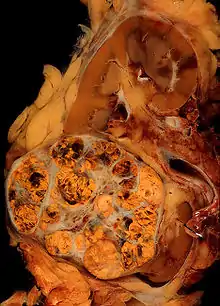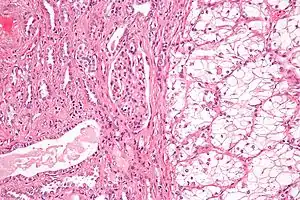Clear cell renal cell carcinoma
Clear cell renal cell carcinoma (CCRCC) is a type of renal cell carcinoma.
Genetics
Cytogenetics
- Alterations of chromosome 3p segments occurs in 70 – 90% of CCRCCs
- Inactivation of von Hippel–Lindau disease (VHL) gene by gene mutation and promoter hypermethylation
- Gain of chromosome 5q
- Loss of chromosomes 8p, 9p, and 14q
Molecular genetics
Several frequently mutated genes were discovered in CCRCC: VHL, KDM6A/UTX, SETD2, KDM5C/JARID1C and MLL2. PBRM1 is also commonly mutated in CCRCC.
Histogenesis
CCRCC is derived from the proximal convoluted tubule.
Microscopy
Generally, the cells have a clear cytoplasm, are surrounded by a distinct cell membrane and contain round and uniform nuclei.
Microscopically, CCRCCs are graded by the ISUP/WHO as follows:[1][2]
- Grade 1: Inconspicuous and basophilic nucleoli at ×400 magnification
- Grade 2: Clearly visible and eosinophilic nucleoli at ×400 magnification
- Grade 3: Clearly visible nucleoli at ×100 magnification
- Grade 4: Extreme pleomorphism or rhabdoid and/or sarcomatoid morphology
Epidemiology
- Most commonly affects male patients in their sixties and seventies.
- Majority of CCRCC arise sporadically.
- Only 2–4% of the cases presenting as part of an inherited cancer syndrome, such as Von Hippel–Lindau disease.
Images
 Clear cell renal cell carcinoma. Macroscopy.
Clear cell renal cell carcinoma. Macroscopy. Clear cell renal cell carcinoma. HE, x100.
Clear cell renal cell carcinoma. HE, x100._Nephrectomy.jpg.webp) Clear cell renal cell carcinoma. Führman Grade = 1. HE, x400.
Clear cell renal cell carcinoma. Führman Grade = 1. HE, x400. Grade 3: Arrows point at a clearly visible nucleolus.
Grade 3: Arrows point at a clearly visible nucleolus.
References
- YiFen Zhang. "What is the ISUP/WHO grading system for renal cell carcinoma (RCC)?". Medscape. Updated: Jul 02, 2019
- Moch, H. (2016). "WHO-ISUP-Graduierungssystem für Nierenkarzinome". Der Pathologe. 37 (4): 355–360. doi:10.1007/s00292-016-0171-y. ISSN 0172-8113.
This article is issued from Wikipedia. The text is licensed under Creative Commons - Attribution - Sharealike. Additional terms may apply for the media files.